airbag MERCEDES-BENZ GLC SUV 2015 Owners Manual
[x] Cancel search | Manufacturer: MERCEDES-BENZ, Model Year: 2015, Model line: GLC SUV, Model: MERCEDES-BENZ GLC SUV 2015Pages: 497, PDF Size: 15.27 MB
Page 7 of 497
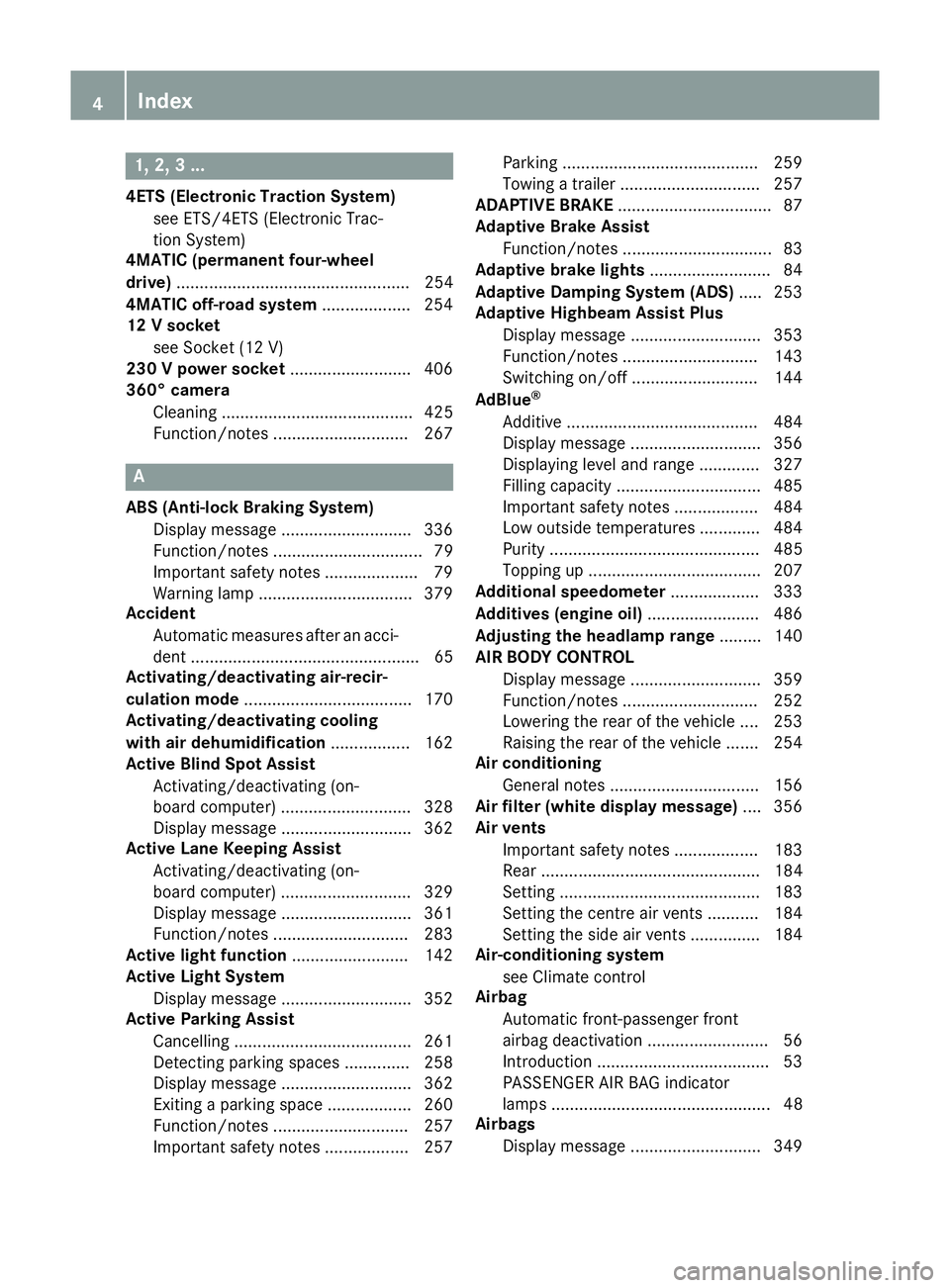
1, 2, 3 ...
4ETS (Electronic Traction System) see ETS/4ETS (Electronic Trac-
tion System)
4MATIC (permanent four-wheel
drive) .................................................. 254
4MATIC off-road system ...................254
12 V socket
see Socket (12 V)
230 V power socket .......................... 406
360° camera
Cleaning ......................................... 425
Function/notes ............................ .267 A
ABS (Anti-lock Braking System) Display message ............................ 336
Function/notes ................................ 79
Important safety notes .................... 79
Warning lamp ................................. 379
Accident
Automatic measures after an acci-
dent ................................................. 65
Activating/deactivating air-recir-
culation mode ................................... .170
Activating/deactivating cooling
with air dehumidification ................. 162
Active Blind Spot Assist
Activating/deactivating (on-
board computer) ............................ 328
Display message ............................ 362
Active Lane Keeping Assist
Activating/deactivating (on-
board computer) ............................ 329
Display message ............................ 361
Function/notes ............................ .283
Active light function ......................... 142
Active Light System
Display message ............................ 352
Active Parking Assist
Cancelling ...................................... 261
Detecting parking spaces .............. 258
Display message ............................ 362
Exiting a parking space .................. 260
Function/notes ............................ .257
Important safety notes .................. 257 Parking .......................................... 259
Towing a trailer .............................. 257
ADAPTIVE BRAKE ................................. 87
Adaptive Brake Assist
Function/notes ................................ 83
Adaptive brake lights .......................... 84
Adaptive Damping System (ADS) ..... 253
Adaptive Highbeam Assist Plus
Display message ............................ 353
Function/notes ............................ .143
Switching on/off ........................... 144
AdBlue ®
Additive ......................................... 484
Display message ............................ 356
Displaying level and range ............. 327
Filling capacity ............................... 485
Important safety notes .................. 484
Low outside temperatures ............. 484
Purity ............................................. 485
Topping up ..................................... 207
Additional speedometer ................... 333
Additives (engine oil) ........................ 486
Adjusting the headlamp range ......... 140
AIR BODY CONTROL
Display message ............................ 359
Function/notes ............................ .252
Lowering the rear of the vehicle .... 253
Raising the rear of the vehicle ....... 254
Air conditioning
General notes ................................ 156
Air filter (white display message) .... 356
Air vents
Important safety notes .................. 183
Rear ............................................... 184
Setting .......................................... .183
Setting the centre air vents ........... 184
Setting the side air vents .............. .184
Air-conditioning system
see Climate control
Airbag
Automatic front-passenger front
airbag deactivatio n .......................... 56
Introduction ..................................... 53
PASSENGER AIR BAG indicator
lamps ............................................... 48
Airbags
Display message ............................ 349 4
Index
Page 8 of 497
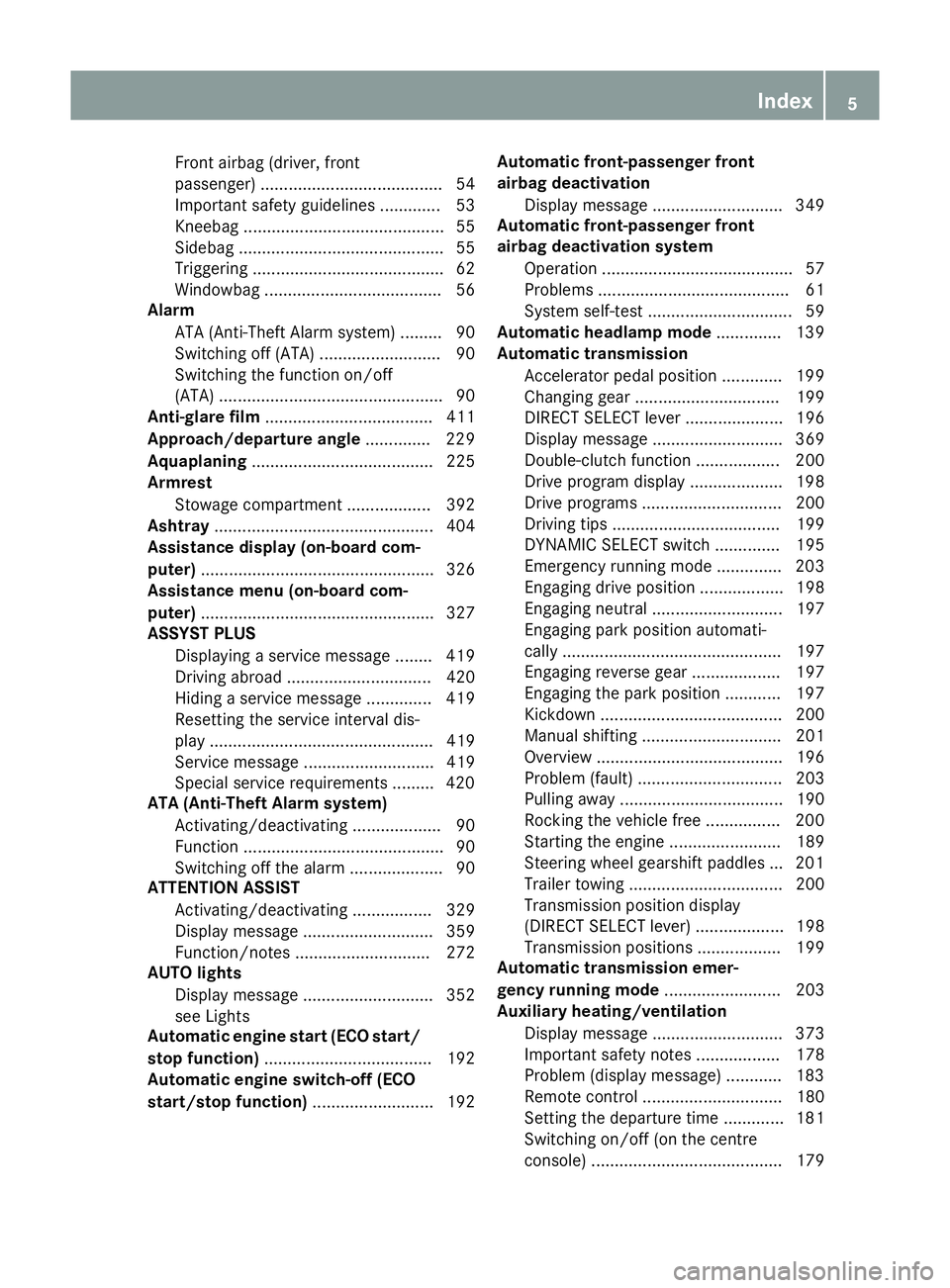
Front airbag (driver, front
passenger) ....................................... 54
Important safety guidelines ............. 53
Kneebag ........................................... 55
Sidebag ............................................ 55
Triggering ......................................... 62
Windowbag ...................................... 56
Alarm
ATA (Anti-Theft Alarm system) ......... 90
Switching off (ATA) .......................... 90
Switching the function on/off
(ATA) ................................................ 90
Anti-glare film .................................... 411
Approach/departure angle .............. 229
Aquaplaning ....................................... 225
Armrest
Stowage compartment .................. 392
Ashtray ............................................... 404
Assistance display (on-board com-
puter) .................................................. 326
Assistance menu (on-board com-
puter) .................................................. 327
ASSYST PLUS
Displaying a service messag e........ 419
Driving abroad ............................... 420
Hiding a service message .............. 419
Resetting the service interval dis-
play ................................................ 419
Service message ............................ 419
Special service requirements ......... 420
ATA (Anti-Theft Alarm system)
Activating/deactivating ................... 90
Function ........................................... 90
Switching off the alarm .................... 90
ATTENTION ASSIST
Activating/deactivating ................. 329
Display message ............................ 359
Function/note s............................. 272
AUTO lights
Display message ............................ 352
see Lights
Automatic engine start (ECO start/
stop function) .................................... 192
Automatic engine switch-off (ECO
start/stop function) .......................... 192 Automatic front-passenger front
airbag deactivation
Display message ............................ 349
Automatic front-passenger front
airbag deactivation system
Operation ......................................... 57
Problems ......................................... 61
System self-test ............................... 59
Automatic headlamp mode .............. 139
Automatic transmission
Accelerator pedal position ............. 199
Changing gear ............................... 199
DIRECT SELECT lever ..................... 196
Display message ............................ 369
Double-clutch function .................. 200
Drive program display .................... 198
Drive programs .............................. 200
Driving tips .................................... 199
DYNAMIC SELECT switch .............. 195
Emergency running mode .............. 203
Engaging drive position .................. 198
Engaging neutral ............................ 197
Engaging park position automati-
cally ............................................... 197
Engaging reverse gear ................... 197
Engaging the park position ............ 197
Kickdown ....................................... 200
Manual shifting .............................. 201
Overview ........................................ 196
Problem (fault) ............................... 203
Pulling away ................................... 190
Rocking the vehicle free ................ 200
Starting the engine ........................ 189
Steering wheel gearshift paddle s... 201
Trailer towing ................................. 200
Transmission position display
(DIRECT SELECT lever) ................... 198
Transmission positions .................. 199
Automatic transmission emer-
gency running mode ......................... 203
Auxiliary heating/ventilation
Display message ............................ 373
Important safety notes .................. 178
Problem (display message) ............ 183
Remote control .............................. 180
Setting the departure time ............. 181
Switching on/off (on the centre
console) ......................................... 179 Index
5
Page 15 of 497

Front-passenger front airbag deac-
tivation
Display message ............................ 349
Front-passenger front airbag deac-
tivation system
Operation ........................................ .57
Problems ......................................... 61
System self-test ...............................59
Fuel
Additives ........................................ 483
Consumption information .............. 484
Consumption statistics .................. 319
Displaying the current consump-
tion ................................................ 318
Displaying the range ...................... 318
Driving tips .................................... 222
E10 ................................................ 482
Fuel gauge ...................................... .34
Grade (petrol) ................................ 482
Important safety notes .................. 481
Low outside temperatures ............ .483
Problem (malfunction) ................... 206
Quality (diesel )............................... 483
Refuelling ....................................... 203
Tank content/reserve fue l............. 482
Fuel filler flap
Opening ......................................... 205
Fuel filter (white display message) .. 356
Fuel level
Calling up the range (on-board
computer) ...................................... 318
Gaug e.............................................. 34
Fuel tank
Capacity ........................................ 482
Problem (malfunction) ................... 206
Fuses
Allocation chart ............................. 451
Before changing ............................. 449
Dashboard fuse box ....................... 449
Fuse box in the engine compart-
ment .............................................. 450
Fuse box in the front-passenger
footwell .......................................... 449
Fuse box in the luggage compart-
ment .............................................. 451
Important safety notes .................. 448 G
Gearshift paddles see Steering wheel gearshift paddles
Genuine Mercedes-Benz parts ........... 25
Glove compartment .......................... 391 H
HANDS-FREE ACCESS ....................... 106
Hazard warning lamps ...................... 141
Head restraint
General notes ................................ 124
Head restraints
Adjusting (electrically) ................... 124
Adjusting (manually) ...................... 124
Adjusting (rear) .............................. 125
Adjusting the fore-and-aft posi-
tion manually ................................. 124
Fitting/removing (rear) .................. 125
Important safety notes .................. 123
Head-up display
Adjusting the brightness ................ 331
Displays and operating .................. 316
Function/note s............................. 315
Important safety notes .................. 316
Selecting displays .......................... 330
Setting the position ....................... 331
Storing settings (memory func-
tion) ............................................... 135
Headlamp
Cleaning system (notes) ................ 487
Headlamp flasher .............................. 141
Headlamps
Misting up ...................................... 144
see Automatic headlamp mode
Heating
see Climate control
High-pressure cleaners .................... 422
High-voltage battery
Battery car e................................... 212
Charging (charging station) ............ 217
Charging (mains socket) ................ 213
Charging (wallbox) ......................... 216
Charging cable heating up ............. 212
Energy consumption ...................... 212
General notes .................................. 45
Method of operation ...................... 211 12
Index
Page 18 of 497

Maximum charge current
Setting (charging cable) ................. 214
Setting (on-board computer) .......... 329
Memory card (audio) ......................... 323
Memory function
Seats, steering wheel, exterior
mirrors ........................................... 134
Mercedes-Benz Contact
Display message ............................ 343
General notes ................................ 409
Info call button .............................. 409
Roadside Assistance call button .... 409
Mercedes-Benz emergency call
system
Switch in the overhead control
panel ............................................. .408
Mercedes-Benz Intelligent Drive
360°camera .................................. 267
Active Blind Spot Assist ................. 280
Active Lane Keeping Assist ............ 283
Active Parking Assist ..................... 257
ATTENTION ASSIST ........................ 272
Blind Spot Assist ............................ 276
DISTRONIC PLUS ........................... 236
DISTRONIC PLUS with Steering
Assist and Stop&Go Pilot .............. .245
General notes ................................ 230
Lane Keeping Assist ..................... .279
PARKTRONIC ................................. 254
PRE-SAFE ®
(anticipatory occu-
pant protection) ............................... 63
PRE-SAFE ®
PLUS (anticipatory
occupant protection PLUS) .............. 64
Reversing camera .......................... 262
Traffic Sign Assist .......................... 274
Mercedes-Benz Service Centre
see Qualified specialist workshop
Message memory (on-board com-
puter) ................................................. .335
Messages
see Display messages
see Warning and indicator lamps
Mirror turn signal
Cleaning ......................................... 424
Mirrors
see Exterior mirrors
see Rear-view mirror see Vanity mirror (in sun visor)
Mobile phone
Frequencies ................................... 478
Installation ..................................... 478
Menu (on-board computer) ............ 324
Notes/placing in the bracket ......... 410
Transmission output (maximum) .... 478
Modifying the programming (key) ..... 96
MOExtended tyres .............................434
Motorway mode ................................ 142
MP3
Operating ....................................... 323
Multifunction display
Function/notes ............................ .315
Permanent display ......................... 333
Multifunction steering wheel
Operating the on-board computer .. 314
Overview .......................................... 37 N
Navigation Menu (on-board computer) ............ 320
Notes on running in a new vehicle .. 186 O
Occupant safety Automatic front-passenger front
airbag deactivatio n .......................... 56
Automatic measures after an acci-
dent ................................................. 65
Children in the vehicle ..................... 65
Important safety notes .................... 47
PASSENGER AIRBAG indicator
lamp ................................................. 48
Pets in the vehicle ........................... 78
PRE-SAFE ®
(anticipatory occu-
pant protection) ............................... 63
PRE-SAFE ®
PLUS (anticipatory
occupant protection PLUS) .............. 64
Restraint system introduction .......... 46
Restraint system warning lamp ....... .47
Seat belts ........................................ 48
Odometer ........................................... 318
Off-road driving
Approach/departure angle ............ 489
Checklist after driving off-road ...... 228 Index
15
Page 28 of 497
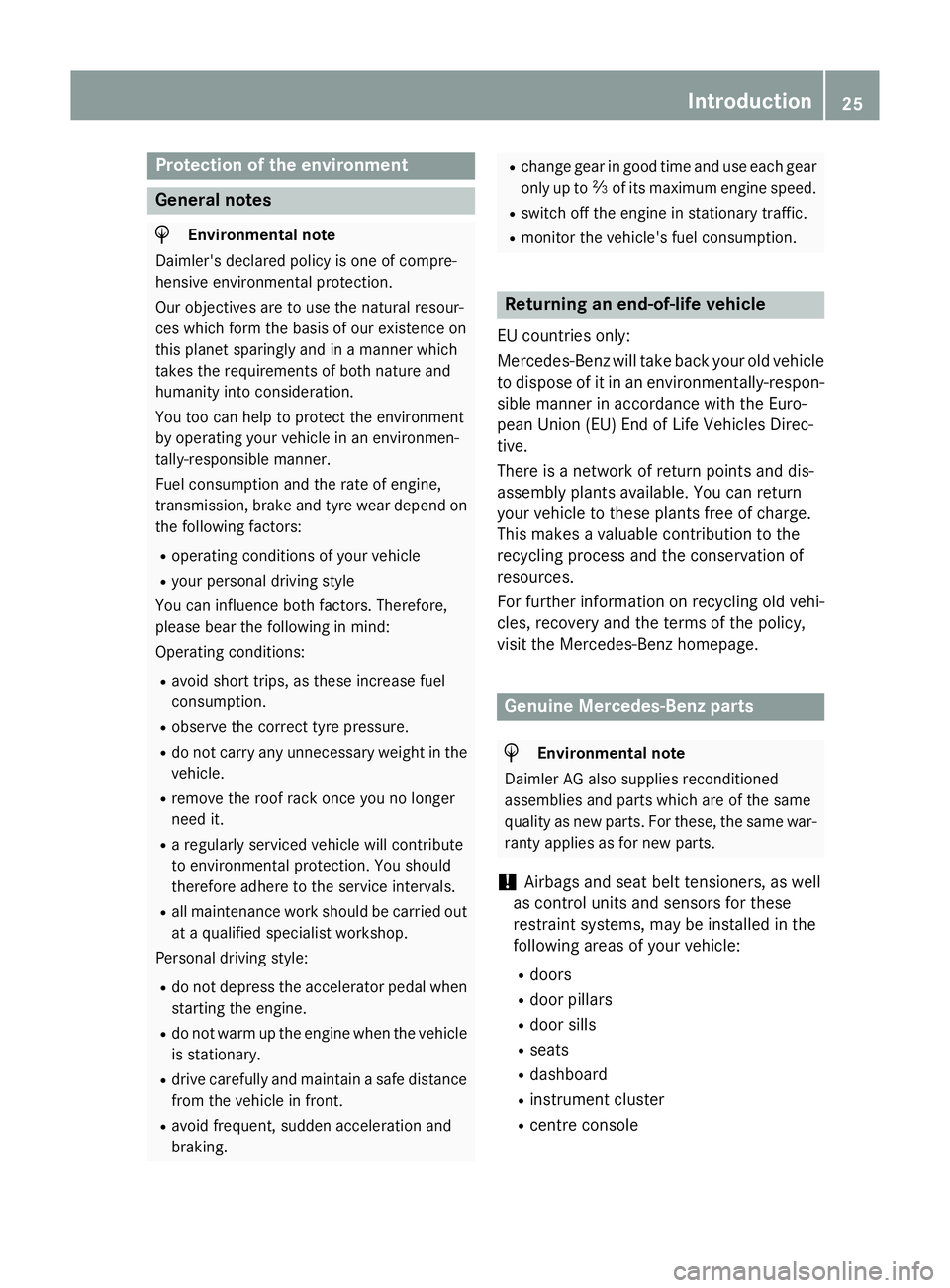
Protection of the environment
General notes
H
Environmental note
Daimler's declared policy is one of compre-
hensive environmental protection.
Our objectives are to use the natural resour-
ces which form the basis of our existence on
this planet sparingly and in a manner which
takes the requirements of both nature and
humanity into consideration.
You too can help to protect the environment
by operating your vehicle in an environmen-
tally-responsible manner.
Fuel consumption and the rate of engine,
transmission, brake and tyre wear depend on
the following factors:
R operating conditions of your vehicle
R your personal driving style
You can influence both factors. Therefore,
please bear the following in mind:
Operating conditions:
R avoid short trips, as these increase fuel
consumption.
R observe the correct tyre pressure.
R do not carry any unnecessary weight in the
vehicle.
R remove the roof rack once you no longer
need it.
R a regularly serviced vehicle will contribute
to environmental protection. You should
therefore adhere to the service intervals.
R all maintenance work should be carried out
at a qualified specialist workshop.
Personal driving style:
R do not depress the accelerator pedal when
starting the engine.
R do not warm up the engine when the vehicle
is stationary.
R drive carefully and maintain a safe distance
from the vehicle in front.
R avoid frequent, sudden acceleration and
braking. R
change gear in good time and use each gear
only up to Ôof its maximum engine speed.
R switch off the engine in stationary traffic.
R monitor the vehicle's fuel consumption. Returning an end-of-life vehicle
EU countries only:
Mercedes-Benz will take back your old vehicle to dispose of it in an environmentally-respon-sible manner in accordance with the Euro-
pean Union (EU) End of Life Vehicles Direc-
tive.
There is a network of return points and dis-
assembly plants available. You can return
your vehicle to these plants free of charge.
This makes a valuable contribution to the
recycling process and the conservation of
resources.
For further information on recycling old vehi- cles, recovery and the terms of the policy,
visit the Mercedes-Benz homepage. Genuine Mercedes-Benz parts
H
Environmental note
Daimler AG also supplies reconditioned
assemblies and parts which are of the same
quality as new parts. For these, the same war-
ranty applies as for new parts.
! Airbags and seat belt tensioners, as well
as control units and sensors for these
restraint systems, may be installed in the
following areas of your vehicle:
R doors
R door pillars
R door sills
R seats
R dashboard
R instrument cluster
R centre console Introduction
25 Z
Page 32 of 497

QR code for rescue card
The QR code is secured in the fuel filler flap
and on the opposite side on the B-pillar. In the
event of an accident, rescue services can use
the QR code to quickly find the appropriate
rescue card for your vehicle. The current res- cue card contains, in a compact form, the
most important information about your vehi-
cle, e.g. the routing of the electric cables.
You can find more information under http:// portal.aftersales.i.daimler.com/public/
content/asportal/en/communication/
informationen_fuer/QRCode.html. Data stored in the vehicle
A wide range of electronic components in
your vehicle contain data memories.
These data memories temporarily or perma-
nently store technical information about:
R the vehicle's operating state
R events
R faults
In general, this technical information docu-
ments the state of a component, a module, a
system or the surroundings.
These include, for example:
R operating conditions of system compo-
nents, e.g. fluid levels
R the vehicle's status messages and those of
its individual components, e.g. number of
wheel revolutions/speed, deceleration in
movement, lateral acceleration, accelera-
tor pedal position
R malfunctions and defects in important sys-
tem components, e.g. lights, brakes
R vehicle reactions and operating conditions
in special driving situations, e.g. airbag
deployment, intervention of stability con-
trol systems
R ambient conditions, e.g. outside tempera-
ture This data is of an exclusively technical nature
and can be used to:
R assist in detecting and rectifying faults and
defects
R analyse vehicle functions, e.g. after an acci-
dent
R optimise vehicle functions
The data cannot be used to trace the vehicle's movements.
When your vehicle is serviced, technical infor-
mation can be read from the event data mem- ory and fault data memory.
Services include, for example:
R repair services
R service processes
R warranty events
R quality assurance
The vehicle is read out by employees of the
service network (including the manufacturer)
using special diagnostic testers. You can
obtain more information there, if required.
After a fault has been rectified, the informa-
tion is deleted from the fault memory or is
continually overwritten.
When operating the vehicle, situations are
conceivable in which this technical data, in
connection with other information (if neces-
sary, after consultation with an authorised
expert), could be traced to a person.
Examples include:
R accident reports
R damage to the vehicle
R witness statements
Further additional functions that have been
contractually agreed upon with the customer
allow certain vehicle data to be conveyed by
the vehicle as well. The additional functions
include, for example, vehicle location in case of an emergency. Introduction
29 Z
Page 42 of 497
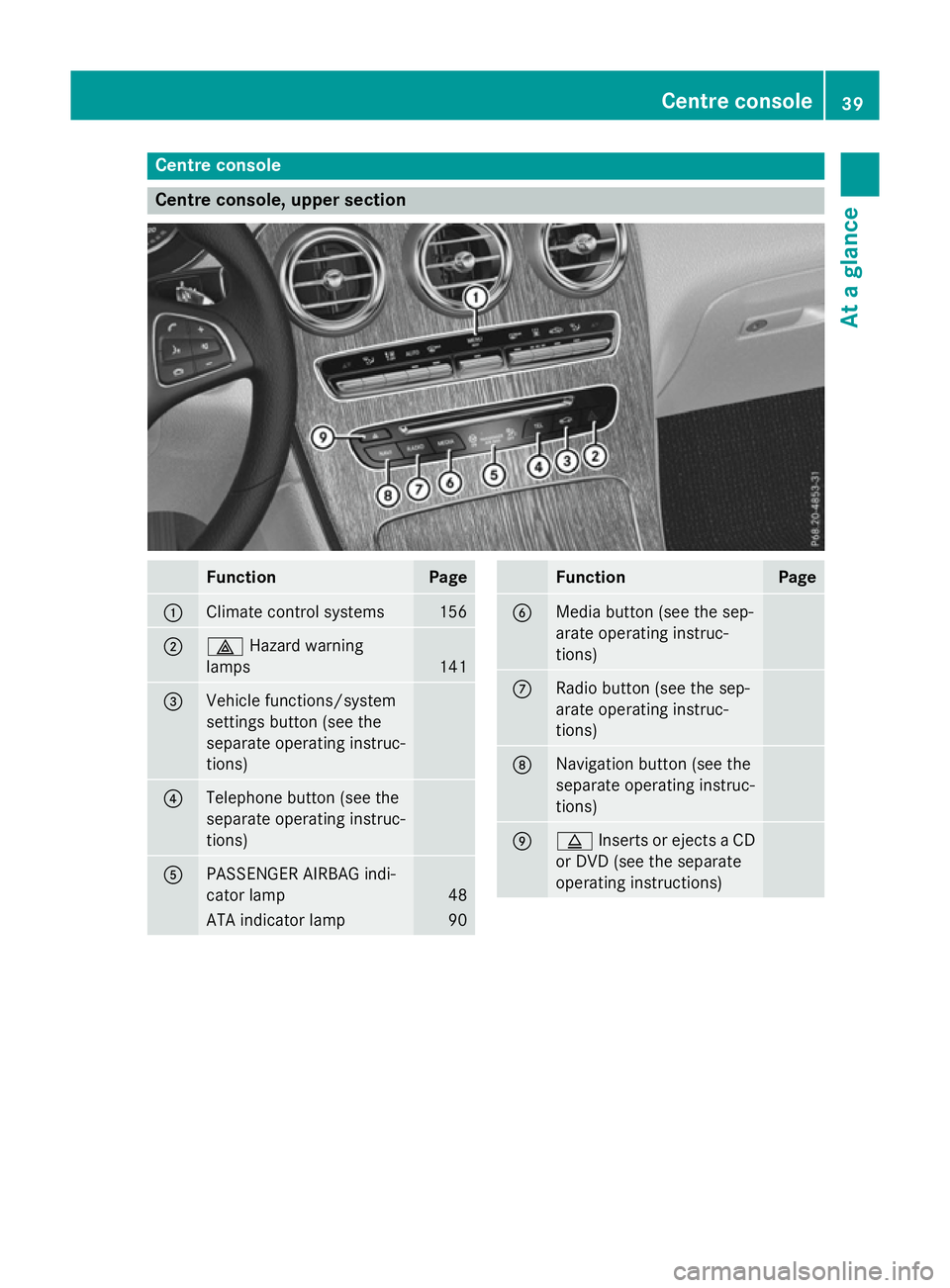
Centre console
Centre console, upper section
Function Page
:
Climate control systems 156
;
£
Hazard warning
lamps 141
=
Vehicle functions/system
settings button (see the
separate operating instruc-
tions) ?
Telephone button (see the
separate operating instruc-
tions) A
PASSENGER AIRBAG indi-
cator lamp
48
ATA indicator lamp 90 Function Page
B
Media button (see the sep-
arate operating instruc-
tions)
C
Radio button (see the sep-
arate operating instruc-
tions) D
Navigation button (see the
separate operating instruc-
tions)
E
þ
Inserts or ejects a CD
or DVD (see the separate
operating instructions) Centre console
39At a glance
Page 49 of 497
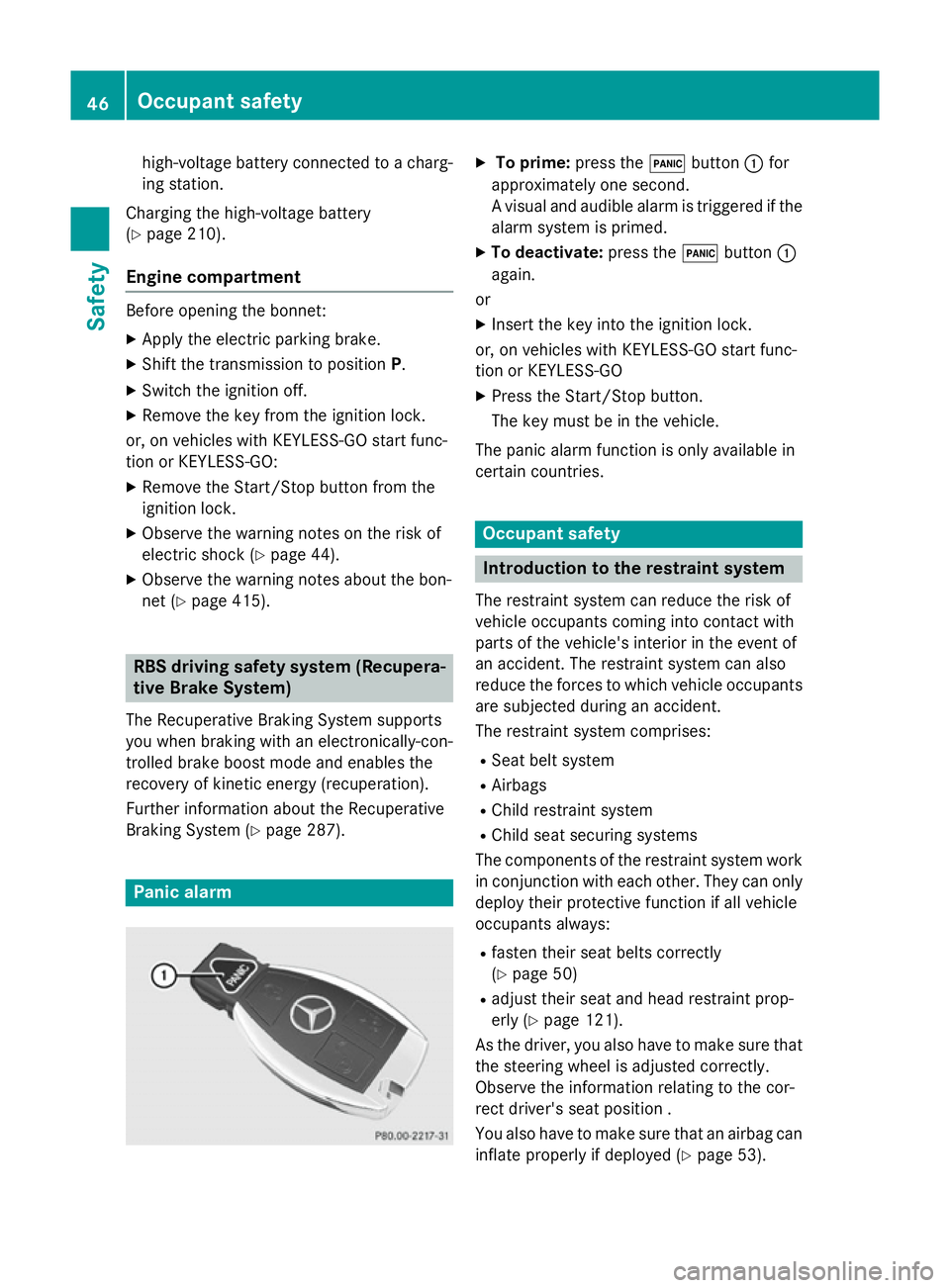
high-voltage battery connected to a charg-
ing station.
Charging the high-voltage battery
(Y page 210).
Engine compartment Before opening the bonnet:
X Apply the electric parking brake.
X Shift the transmission to position P.
X Switch the ignition off.
X Remove the key from the ignition lock.
or, on vehicles with KEYLESS-GO start func-
tion or KEYLESS ‑GO:
X Remove the Start/Stop button from the
ignition lock.
X Observe the warning notes on the risk of
electric shock (Y page 44).
X Observe the warning notes about the bon-
net (Y page 415). RBS driving safety system (Recupera-
tive Brake System)
The Recuperative Braking System supports
you when braking with an electronically-con-
trolled brake boost mode and enables the
recovery of kinetic energy (recuperation).
Further information about the Recuperative
Braking System (Y page 287).Panic alarm X
To prime: press the!button :for
approximately one second.
A visual and audible alarm is triggered if the alarm system is primed.
X To deactivate: press the!button :
again.
or
X Insert the key into the ignition lock.
or, on vehicles with KEYLESS-GO start func-
tion or KEYLESS ‑GO
X Press the Start/Stop button.
The key must be in the vehicle.
The panic alarm function is only available in
certain countries. Occupant safety
Introduction to the restraint system
The restraint system can reduce the risk of
vehicle occupants coming into contact with
parts of the vehicle's interior in the event of
an accident. The restraint system can also
reduce the forces to which vehicle occupants are subjected during an accident.
The restraint system comprises:
R Seat belt system
R Airbags
R Child restraint system
R Child seat securing systems
The components of the restraint system work
in conjunction with each other. They can only
deploy their protective function if all vehicle
occupants always:
R fasten their seat belts correctly
(Y page 50)
R adjust their seat and head restraint prop-
erly (Y page 121).
As the driver, you also have to make sure that
the steering wheel is adjusted correctly.
Observe the information relating to the cor-
rect driver's seat position .
You also have to make sure that an airbag can
inflate properly if deployed (Y page 53).46
Occupant safetySafety
Page 50 of 497
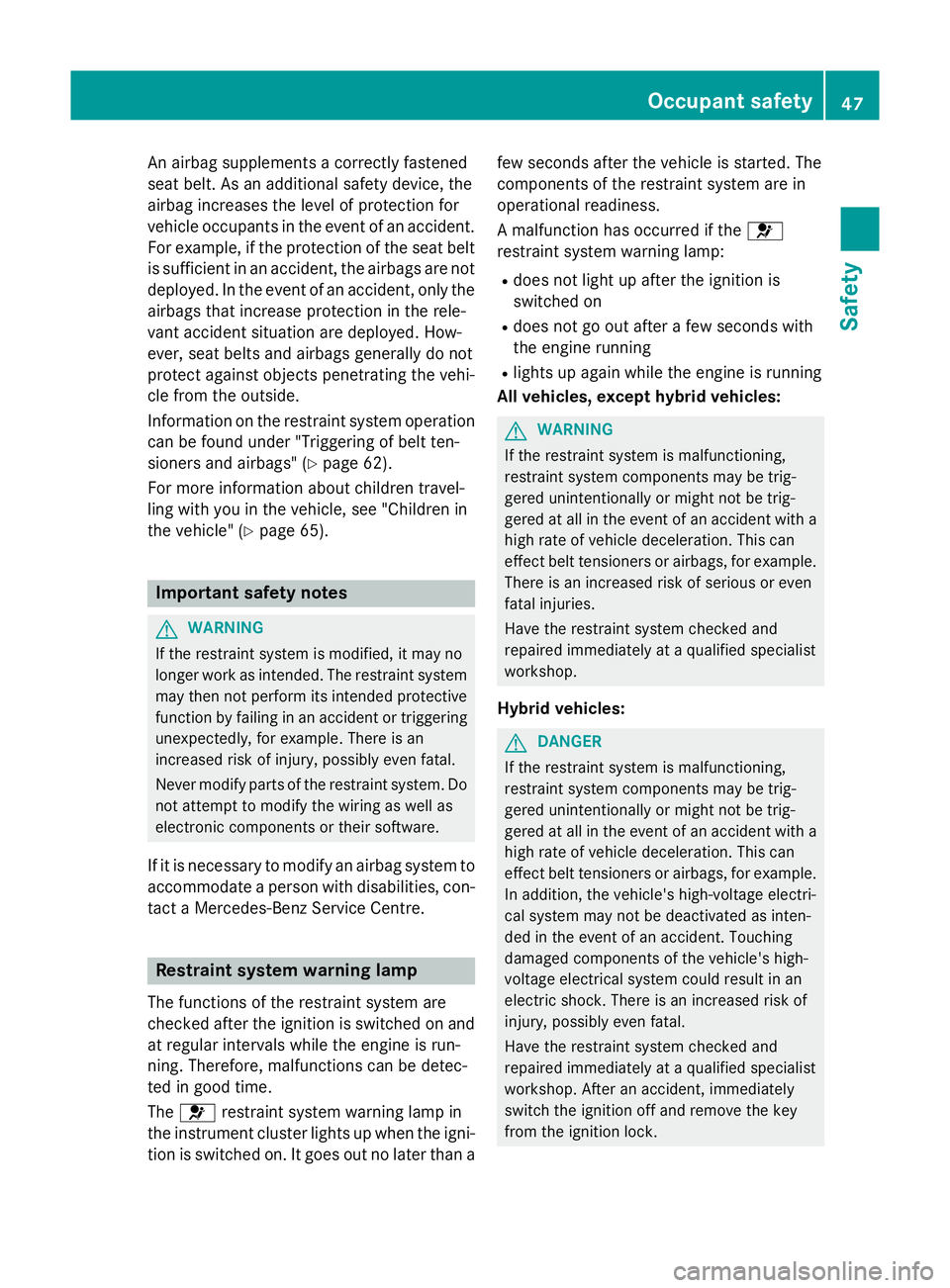
An airbag supplements a correctly fastened
seat belt. As an additional safety device, the
airbag increases the level of protection for
vehicle occupants in the event of an accident.
For example, if the protection of the seat belt is sufficient in an accident, the airbags are not
deployed. In the event of an accident, only the airbags that increase protection in the rele-
vant accident situation are deployed. How-
ever, seat belts and airbags generally do not
protect against objects penetrating the vehi-
cle from the outside.
Information on the restraint system operation
can be found under "Triggering of belt ten-
sioners and airbags" (Y page 62).
For more information about children travel-
ling with you in the vehicle, see "Children in
the vehicle" (Y page 65). Important safety notes
G
WARNING
If the restraint system is modified, it may no
longer work as intended. The restraint system
may then not perform its intended protective function by failing in an accident or triggering
unexpectedly, for example. There is an
increased risk of injury, possibly even fatal.
Never modify parts of the restraint system. Do not attempt to modify the wiring as well as
electronic components or their software.
If it is necessary to modify an airbag system to
accommodate a person with disabilities, con- tact a Mercedes-Benz Service Centre. Restraint system warning lamp
The functions of the restraint system are
checked after the ignition is switched on and at regular intervals while the engine is run-
ning. Therefore, malfunctions can be detec-
ted in good time.
The 6 restraint system warning lamp in
the instrument cluster lights up when the igni- tion is switched on. It goes out no later than a few seconds after the vehicle is started. The
components of the restraint system are in
operational readiness.
A malfunction has occurred if the
6
restraint system warning lamp:
R does not light up after the ignition is
switched on
R does not go out after a few seconds with
the engine running
R lights up again while the engine is running
All vehicles, except hybrid vehicles: G
WARNING
If the restraint system is malfunctioning,
restraint system components may be trig-
gered unintentionally or might not be trig-
gered at all in the event of an accident with a high rate of vehicle deceleration. This can
effect belt tensioners or airbags, for example. There is an increased risk of serious or even
fatal injuries.
Have the restraint system checked and
repaired immediately at a qualified specialist
workshop.
Hybrid vehicles: G
DANGER
If the restraint system is malfunctioning,
restraint system components may be trig-
gered unintentionally or might not be trig-
gered at all in the event of an accident with a high rate of vehicle deceleration. This can
effect belt tensioners or airbags, for example. In addition, the vehicle's high-voltage electri-
cal system may not be deactivated as inten-
ded in the event of an accident. Touching
damaged components of the vehicle's high-
voltage electrical system could result in an
electric shock. There is an increased risk of
injury, possibly even fatal.
Have the restraint system checked and
repaired immediately at a qualified specialist
workshop. After an accident, immediately
switch the ignition off and remove the key
from the ignition lock. Occupant safety
47Safety Z
Page 51 of 497
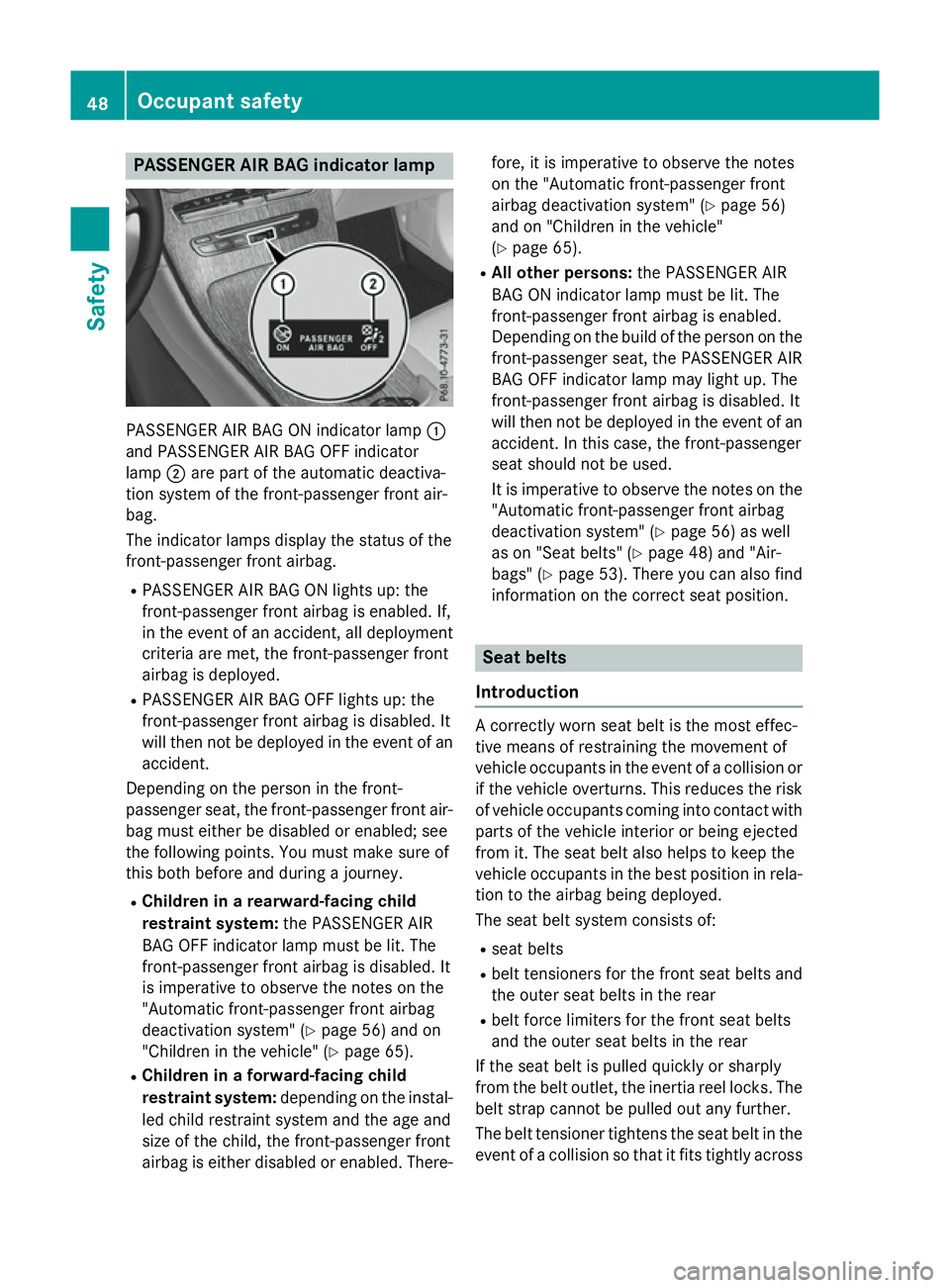
PASSENGER AIR BAG indicator lamp
PASSENGER AIR BAG ON indicator lamp
:
and PASSENGER AIR BAG OFF indicator
lamp ;are part of the automatic deactiva-
tion system of the front-passenger front air-
bag.
The indicator lamps display the status of the
front-passenger front airbag.
R PASSENGER AIR BAG ON lights up: the
front-passenger front airbag is enabled. If,
in the event of an accident, all deployment
criteria are met, the front-passenger front
airbag is deployed.
R PASSENGER AIR BAG OFF lights up: the
front-passenger front airbag is disabled. It
will then not be deployed in the event of an
accident.
Depending on the person in the front-
passenger seat, the front-passenger front air-
bag must either be disabled or enabled; see
the following points. You must make sure of
this both before and during a journey.
R Children in a rearward-facing child
restraint system: the PASSENGER AIR
BAG OFF indicator lamp must be lit. The
front-passenger front airbag is disabled. It
is imperative to observe the notes on the
"Automatic front-passenger front airbag
deactivation system" (Y page 56) and on
"Children in the vehicle" (Y page 65).
R Children in a forward-facing child
restraint system: depending on the instal-
led child restraint system and the age and
size of the child, the front-passenger front
airbag is either disabled or enabled. There- fore, it is imperative to observe the notes
on the "Automatic front-passenger front
airbag deactivation system" (Y
page 56)
and on "Children in the vehicle"
(Y page 65).
R All other persons: the PASSENGER AIR
BAG ON indicator lamp must be lit. The
front-passenger front airbag is enabled.
Depending on the build of the person on the front-passenger seat, the PASSENGER AIR
BAG OFF indicator lamp may light up. The
front-passenger front airbag is disabled. It
will then not be deployed in the event of an
accident. In this case, the front-passenger
seat should not be used.
It is imperative to observe the notes on the "Automatic front-passenger front airbag
deactivation system" (Y page 56) as well
as on "Seat belts" (Y page 48) and "Air-
bags" (Y page 53). There you can also find
information on the correct seat position. Seat belts
Introduction A correctly worn seat belt is the most effec-
tive means of restraining the movement of
vehicle occupants in the event of a collision or
if the vehicle overturns. This reduces the risk of vehicle occupants coming into contact with
parts of the vehicle interior or being ejected
from it. The seat belt also helps to keep the
vehicle occupants in the best position in rela-
tion to the airbag being deployed.
The seat belt system consists of:
R seat belts
R belt tensioners for the front seat belts and
the outer seat belts in the rear
R belt force limiters for the front seat belts
and the outer seat belts in the rear
If the seat belt is pulled quickly or sharply
from the belt outlet, the inertia reel locks. The
belt strap cannot be pulled out any further.
The belt tensioner tightens the seat belt in the event of a collision so that it fits tightly across 48
Occupant safetySafety